

| Invertebrate news 2013 |
| Featuring news and sightings from Eakring and Sherwood Forest |
| In most cases, clicking on the photos will link to larger images or related pages |
|
Second county record of the spider Parasteatoda
tepidariorum During a brief wander around Woodthorpe Grange at Nottingham in late September, we visited the Tropical House there to look for invertebrates and was delighted to find several large female Parasteatoda tepidariorum around the greenhouse framework and windows. Similar to our native Parasteatoda lunata (formerly known as Achaearanea lunata following a recent name change) this introduced spider is largely confined to warm buildings and especially greenhouses and unlike the latter species. It does not build a retreat and sites openly in the middle of its web. The increase in garden centres has no doubt helped in its spread and it is probably at many more garden cetres across the county. |
||
| A new Coleophora moth for
Nottinghamshire A surprising addition to the Nottinghamshire list in September 2013, when we found two full grown larval cases of Coleophora inulae on Fleabane (Pulicaria dysenterica) at Warsop Main Pit Top. This is a very local moth of Nationally notable A status, believed to be declining and found at only a handful of UK sites. Following the discovery of C. inulae, we made a return visit to the same site the next day and soon found the Pistol case-bearer Coleophora discordella on Birds-foot Trefoil, which again turned out to be another rarely recorded Nottinghamshire moth. |
||
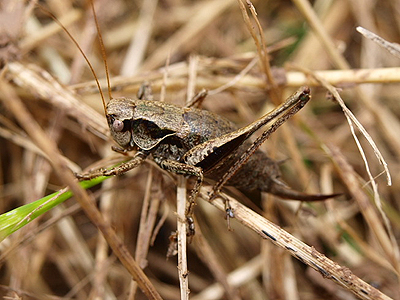 |
Dark
Bush Cricket in Nottinghamshire Following an initial email we recieved on 25/09/13 and following a series of emails with confirmation photographs, we have been able to confrim that Dark Bush Cricket has been recorded in Nottinghamshire for the first time since 2003. The last known records came from the Bingham Linear Park and a thorough search of the area by Roy Frost in 2011 proved fruitless. So this recent discovery by Weston couple Louise and Alastair Gordon is extremely important on a county level. They first recorded Dark Bush Cricket there in 2011 and also have Speckled Bush Cricket present. Louise and Alastair have provided us with 10 figure grid references for two sites (one of which is their garden) which we have passed on to Roy Frost, the Notts and Derbys Orthoptera recorder and the accompanying photograph. |
|
|
Corizus hyoscyami again News has just reached us of a previously unknown Nottinghamshire record of the attractive red and black Rhopalid Corizus hyoscyami, with two recorded and photographed at Shelford on 20/04/11 found by Adrian Dutton. Adrian was unaware until recently, that this was a new species for the county until he read of David Yate's recent Southwell record below. |
||
| Corizus
hyoscyami found at Ollerton Following what appeared to be the first county records of Corizus hyoscyami on August 8th and 11th (see below) we immediately started to conduct searches of suitable sites and were successful in finding two adults on wasteground at the Sherwood Business Park at Ollerton on August 18th. Last year, Long-winged Conehead (Conocephalus discolor) was discovered on the same waste ground and we were pleased to see increased numbers of both adults and nymphs present during our search for Corizus. The site is to be built on in the coming years. |
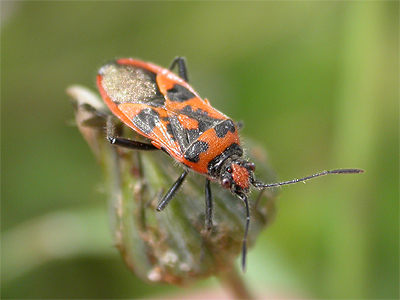 |
|
| A new Nottinghamshire spider and
another new site for Speckled Bush Cricket After making great strides through southern counties of the UK and having been found in neighbouring Leicestershire and South Lincolnshire several years ago, its perhaps surprising that the small, green spider Nigma walckenaeri has passed unnoticed here. But it obviously has, with the first Nottinghamshire record coming from the grounds of Worksop Priory in August 2013. In October 2012 the Priory walls were found to hold numbers of the still un-named Leiobunum Harvestman, we first discovered new to the UK at another Worksop location back in 2009. After walking round the Priory, we then decided to have a casual stroll and search around the old cemetary. Within a few minutes, a small spider was noticed on the underside of a Lilac leaf. Not expecting Nigma, we were amazed to find that it was and so had found the first record for Nottinghamshire and a species we had been asking people to look out for, just a few days before! On the way back from Worksop, we stopped to have a quick look along a strech of grass verge at Carburton and to check suitable Lilac growing at the side of the road for Nigma walckenaeri. We had no success, but did find a female Speckled Bush Cricket - a species either scarce or very under-recorded in Nottinghamshire. The find represents a new 10Km grid square record, which was passed on to Roy Frost, the Nottinghamshire Orthoptera recorder. |
||
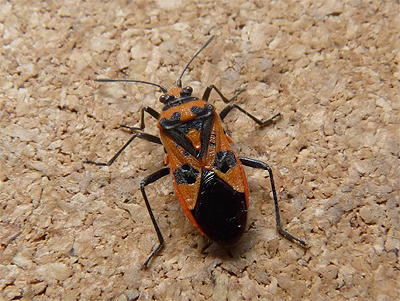 |
Corizus
hyoscyami in Nottinghamshire This beautifully coloured Rhopalid Bug, was once more or less restricted to coastal areas of the UK, but in recent years the number of inland records increased and it had also been found several times in Leicestershire by 2012. It seemed that it was only a matter of time before Corizus hyoscyami reached Nottinghamshire. On August 10th we received an email from David Yates of Southwell, with an attached photograph (see left) of a Bug found in David's garden on August 8th 2013, which David could not identify. We immediately replied saying that his bug was indeed Corizus hyoscyami and that it was a new species for Nottinghamshire based on the info we could find. |
|
| ... | ||
| Imagine our surprise when we had a text the same day from Tim Sexton at Attenborough Nature Reserve, coincidentally at around the same time as we were posting David's photograph on our Facebook page and asking people to keep a look out for this attractive species. Tim's message informed us that a member of the public had just taken a specimen of C. hyoscyami along to the visitor centre at Attenborough for identification! So suddenly, two records for the county in quick successsion. This is one species to clearly be on the look out for. | ||
| Westerly migration of the Peacock
butterfly Renowned migrants the Painted Lady and Red Admiral have long been known to make return southward movements during the late Summer and Autumn months. But another of our common butterflies, is also prone to make similar movements, which seems to largely pass by totally unnoticed. We have recorded the Peacock (Inachis io) moving southwards in previous years, although these movements only seem to occur after the emergence of large numbers of adults in favourable years. While travelling around the Mansfield area on 08/08/13, we noticed numerous Peacock butterflies flying across the various roads, all moving westerly. Unfortunately, we were unable to conduct a migration watch until mid-afternoon. By this time, the cloud was increasing and sunshine was limited, but we still managed a count of 27 Peacocks flying low and direct over a field near Market Warsop. The last big Peacock movement was in 2009, when we recorded 47 moving south-west on 09/08/09, which coincided with a good return movement of Painted Ladies and Large Whites, but a larger movement took place back in 2003, when 106 flew south-west on 03/08/03. Again this movement took place in conjunction with several other species. The weather was very hot and dry at the time and movement was thought to have been triggered by the very dry conditions. Six were noted the following day (04/08/03) and just two were recorded on 06/08/03. During the Spring of 2003, odd Peacocks had been noted moving purposefully north, but little attention to the thought of them being migrants was given at the time. |
||
|
A second record of the Crane Fly Ctenophora
ornata at Sherwood Forest This is another of the large and spectacularly marked Crane Flies, but this species is perhaps the most striking of all. Ctenophora ornata has RDB1 status and is classed as endangered. The only other known UK sites where it occurs with any regularity are the New Forest and at Windsor Great Park. 2013 saw reports of 'unusual' numbers of Ctenophora ornata at Windsor and following an email from John Kramer of the Tipulidae Recording Scheme, to staff at the Sherwood Forest visitor centre in late July, a follow up moth trapping session produced the second record for Sherwood Forest. Sherwood Forest is by far the most northerly site in the UK for this spectacular Crane Fly. |
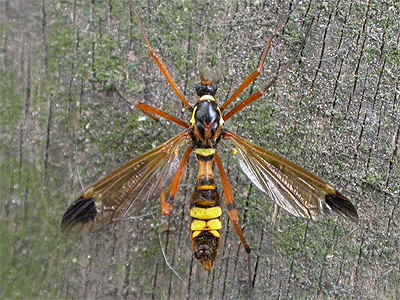 |
|
| Small Ranunculus increasing
throughout Nottinghamshire Small Ranunculus (Hecatera dysodea) is continuing to colonise most of Nottinghamshire, following a spate of recent records. Following reports of several moths nectaring at Valerian in a Worksop garden during July (P. Cadman) we eventually recorded our first Nottinghamshire Small Ranunculus, with one also netted while nectaring at Valerian, in our own Market Warsop garden on 24th July 2013. |
||
|
New Nottinghamshire site for Cryptocephalus
coryli News has just reached us that Cryptocephalus coryli has been recorded at a new site in Nottinghamshire. Allan and Annette Binding sent us the news via email, saying that Allan recorded a single male at a heathland site in Clumber Park earlier in July. They also report that two females have also been found at Whisby in Lincolnshire by Richard Davidson. Whisby was the location of a release scheme a number of years ago and it was thought that the beetle had died out there until Richard' discovery. Searching the tops of Birches at any known or former C. coryli site, will probably reveal that the beetle is still present. |
||
| Silver Hook and an RDB1 micromoth at
Lound Phil Cadman of the IVNR moth study group, recently sent us news of the discovery of a Silver Hook within the Lound Gravel Pit complex. This was the first post-1990 Nottinghamshire record and Phil generously lent us the moth to photograph and feature on www.eakringbirds.com. The news of this find was very quickly followed up with that of the RDB1 micromoth Chrysoclista lathamella, which was found and photographed by Pauline and Alan Bradford. C. lathamella is very rare and found at just a handful of sites across the UK. |
||
| Red-necked Footman recorded for the
fifth time in Nottinghamshire Red-necked Footman is still a great Nottinghamshire rarity, but at last, may be increasing it's range. This adult was one of two trapped at Clipstone Old Quarter on 18/06/13, the first record for the Sherwood Forest area since the 1800's. Sheila Wright, the Nottinghamshire county recorder has kindly provided us with details of the county's four other Red-necked Footman records. One at MV light, Thieves Wood near Mansfield, 25/06/11 (SW/JEO) One at MV light, Wellow Wood, 27/06/09 (SW/JEO) One at MV light, Bunny Wood, 29/06/06 (MD/RW) and one at MV light, Wollaton Park, 24/06/05 (SW) which was the first county record for over 100 years. |
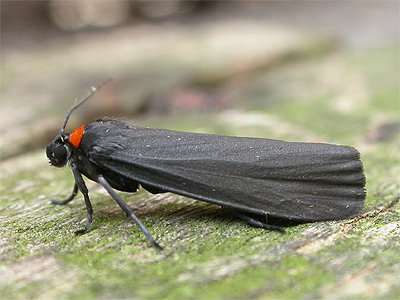 |
|
| Pale Oak Beauty new to Sherwood
Forest NNR Moth trapping at Clipstone Old Quarter on 18th June, was our first trapping session for weeks. Moth numbers generally are considerably higher than in the past two years and included in a total of nearly 300 moths in 1.5 hours trapping time, was a Pale Oak Beauty. This turns out to be a new macro moths for the NNR, a feat not often recorded in recent years. We first recorded Pale Oak Beauty at Eakring back in 2007 when we had three records from Lound Wood. Prior to the Eakring records, there was only one modern Nottinghamshire record of this moth, coming from Misterton in the early 1980's. Pale Oak Beauty is a great Nottinghamshire rarity and the Midlands area in general. |
||
 |
An
unusual invertebrate habitat Its amazing what invertebrates can often be found in the most unlikely places, but a single Common Mallow plant growing in an alley at the rear of the former Bingo Hall at Market Warsop, was found to be hosting four species of Weevil. These small, characteristic Apinonidae Weevils are typically found on the developing flower or seed heads and typcially have a length of 2-4mm. All must be likely on any Mallow, growing in similar situations to that shown in the photograph. There are around five Mallow feeding species, but one is rare and severely restricted in the UK. Malvapion malvae, Aspidapion aeneum, Aspidapion radiolus and Pseudapion rufirostre are all very likely to be found when looked for. |
|
| A late start to the Glow Worm season
Female Glow Worms finally appeared at our usual survey site in Sherwood Forest on June 8th. Numbers nationally are also low, but a colony being monitored daily on the Great Orme in Wales, is already producing very good counts. The Great Orme colony regularly produces counts of hundreds, but habitat and temperature makes it decidedly different from Nottinghamshire's heathland sites. We are also making efforts to monitor two other Sherwood Forest colonies, one at Sherwood Heath and a small roadside colony near Budby. The Sherwood Heath colony produced two counts in excess of 200 females in 2008, but over the last three years numbers have been reduced to single females during our visits. The first female appeared at Sherwood Heath on June 16th. |
||
| Another Nottinghamshire site for the Harvestman Megabunus diadema | ||
| ... | ||
| It took several years of
searching the trunks of trees before we finally found
this gem of a Harvestman. Megabunus diadema is
the most well marked and distinctive of all our native
species, but its cryptic colouration and small size (3mm
body length), mean that it is well concealed on the
trunks of lichen and moss covered trees it favours. We looked in many woodlands searching for this elusive Harvestman, eventually finding it in an area of coppiced woodland at Wellow Park in June 2012. It was found again this year and when we checked the same habitat type at Gamston Wood near Retford, quickly found Megabunus again. There are still only a handful of known sites in the county, but any damp coppiced woodland is worth searching. Typically, they are located about a metre from the ground. |
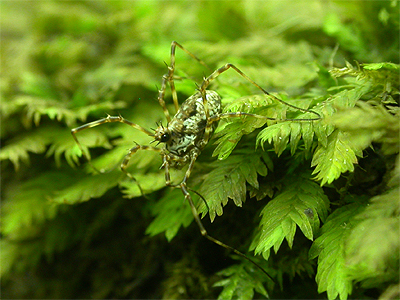 |
|
| Latest news on Cryptocephalus coryli at Sherwood Forest | ||
| ... | ||
| 2013 looks
set for another good year for one of the UK's rarest
beetles, with eight Cryptocephalus coryli adults
found within a few days of the year's first on May 19th. Due to breezy conditions, we have not conducted any tree top surveys to date and all records currently relate to beetles found recently emerged on grasses and other low vegetation, or on Birch and Hawthorn scrub. Six females and two males make up the total. |
||
| A second site for Oil Beetles in Nottinghamshire | ||
| ... | ||
| On 22/04/13 we received
the surprising news of the discovery of the Black Oil
Beetle (Meloe proscarabeus) at a second
Nottinghamshire site by James Glendenning. We visited the site the next day and following a short survey of the area, soon located a total of five males and four females. Unfortunately, these were the only live beetles we found and the dead numbered over 25. At first we were not going to publish the location of the find, but as the discovery centred around the car park and cricket pitch area of Newstead Abbey, felt that public awareness may indeed be the best way of offering some form of protection to the colony. After a string of emails were circulated to various organisations (including Nottingham City Council who manages the area) informing them of the Oil Beetles presence and need of protection, we visited Newstead Abbey again on May 8th, with Ian Major from the Sherwood Forest Trust. |
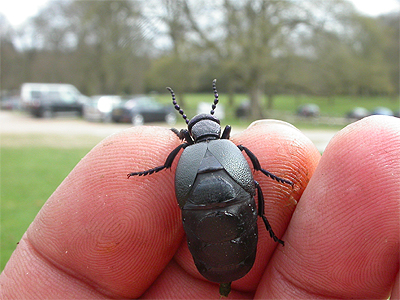 |
|
| ... | ||
| Ian handed over some A5 posters to the head gardener, who will be putting the posters up at strategic points. It is hoped that these may well help to save this very vulnerable colony from such heavy losses in future years and that the cricket club will seek further advice regarding simple protective measures. | ||
| Confirmation of bioluminescence from Geophilus easoni | ||
| ... | ||
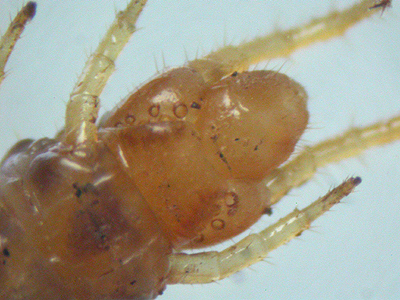 |
Following on from our
recent record of bioluminescence from the Centipede Geophilus
easoni, we began to undertake field work to try and
gain additional evidence and observational notes. We also wanted complete confirmation to our initial identification of G. easoni, ending the still scientifically unknown answer to the question, as to precisely which Centipede (or possibly Centipedes) has the ability to create its own bioluminescence. So two specimens were sent to Tony Barber of the British Myriapod and Isopod Study Group, who quickly confirmed that both were indeed Geophilus easoni. It seems strange that no one had determined bioluminescence in Centipedes before, although G. easoni had been quoted as being bioluminescent by at least one earlier author. The rarity of such reports may have been why no one has spent any time researching the subject. |
|
| ... | ||
| Three
nocturnal path walks yielded a total of 20 G. easoni
(identification later confirmed before release). Out of
the total, 16 produced varying degrees of
bioluminescence. Variability was recorded in the length
of time bioluminescence lasted, exactly where
bioluminescence was emitted from over the length of the
Centipede and the release or non-release of
bioluminescent fluid which was found to have a distinct
odour. Specimens in the larger size range (probably all
mature females) seemed to react better than smaller
specimens. Having such a thin-bodied subject and being in total darkness, did cause us problems in determining exactly where bioluminescence was emitted from. We did not record any specimen becoming completely bioluminescent, but some abdominal sections (tergites) were seen to light up, then fade out, then occasionally lighting up again. Bioluminescent fluid is almost certainly emitted from the underside and possibly from the rear end or the last few tergites. Fluid remains in a state of bioluminescence for around 10-20 seconds, but the odour lasts at least several hours. In another experiment, we tested three specimens of Stigmatogaster subterranea caught earlier in the day. No bioluminscence was recorded. |
||
| Bioluminescence recorded from the Centipede Geophilus easoni | ||
| ... | ||
| We recently recorded a
further example of bioluminescence produced by a
Centipede on April 13th. The Centipede was collected and following examination, has turned out to be Geophilus easoni, a heathland species which we regularly find around the Sherwood Forest area. The identification was also confirmed by Keith Lugg via Facebook, after we posted a photograph showing a ventral view of the Coxal pores. The specimen was found after dark at Clipstone Old Quarter, but was only discovered when it produced a trail of bioluminescent fluid, after almost being trampled on. It did not glow bodily and is not thought to be the same species we recorded at the end of May 2012, but the bioluminescent fluid was easily visible from at least two metres away. The bioluminescence lasted between two and three minutes and when caught, pressing down on the Centipede would produce the same reaction. |
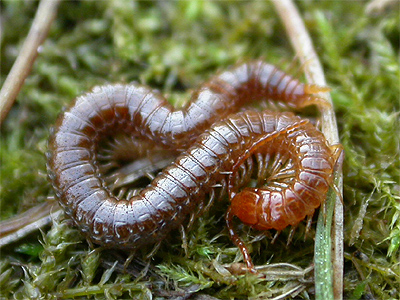 |
|
| First Oil Beetles of 2013 With the temperature actually just reaching into double figures for the first time this Spring, the first Oil Beetles finally emerged at their Budby South Forest site on April 6th. Delayed by the very cold weather during March, when we did make one site visit around mid-month, the first adults (17 males and eight females) were recorded during a thorough survey of the western end of the site. A single female found in a new area, was well away from the main colony and the first real sign of range expansion across the site. |
||
| Winter continues to hold up Spring Winter has been extended this year, with the coldest March temperatures for many years. A prolonged period of easterly winds brought snow to most of the UK mid-month, continuing to delay the start of Spring. In a direct comparison with the end of March 2012, we had already recorded over 60 Oil Beetles on Budby South Forest and seven Glow Worm larvae at our research site of Clipstone Old Quarter (below) in Sherwood Forest. The two photographs below show the same length of forest track, with 2013 on the left and 2012 on the right. This is clearly going to be a late season for many invertebrates. |
||
| ... | ||
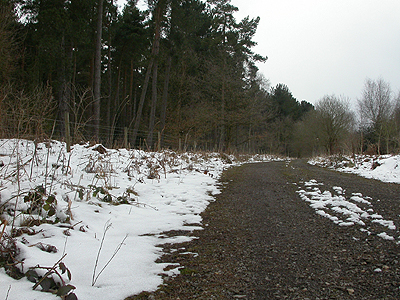 |
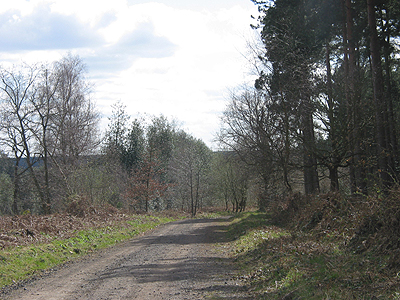 |
|